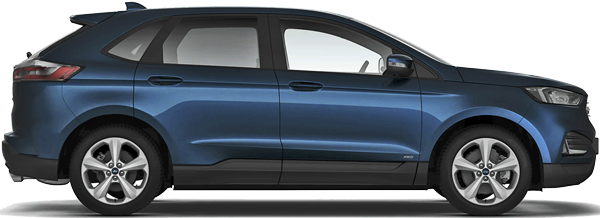The Comparative Analysis :
Ford Edge 2.0 EcoBlue 4x4 (18 - 19) vs. Mercedes EQC 400 4MATIC (19 - ..)
€ 42,900

€ 71,300

€ 42,900
Base Price ⓘBase price of a new vehicle with standard equipment in Germany at market launch.
€ 71,300
ⓘBase price of a new vehicle with standard equipment in Germany at market launch. Price Info
Vehicle Dimensions
The Ford Edge 2.0 EcoBlue is considerably bigger in every dimension. It's 6.5 cm longer, 4.4 cm wider and 12.7 cm taller than the Mercedes EQC 400.
Ford Edge 2.0 EcoBlue
Mercedes EQC 400
1751
1928
2184
1624
1884
2096
1928 mm
Width
1884 mm
2184 mm
Width Incl. Mirrors
2096 mm
1751 mm
Height
1624 mm
2848
4827
2873
4762
4827 mm
Length
4762 mm
2848 mm
Wheelbase
2873 mm
Vehicle Weight
Ford Edge 2.0 EcoBlue
Mercedes EQC 400
2032 kg
Kerb Weight
2495 kg
2590 kg
Gross Vehicle
Weight
Weight
2940 kg

Weight Difference:
463 kg
18.56 %

General
Ford Edge 2.0 EcoBlue
Mercedes EQC 400
SBF
Generation
N293
Sport Utility Vehicle
Car Body Style
Sport Utility Vehicle
Diesel
Fuel Type
Electricity

Permanent all-wheel drive
Drive
Permanent all-wheel drive

6-speed manual transmission
Transmission
1-speed automatic transmission
Engine
Ford Edge 2.0 EcoBlue
Mercedes EQC 400
Straight-four diesel engine with turbocharger
Engine Type
Asynchronous motor
4
Valves
0
4
Cylinders
0
1995 CC
Engine Capacity
0 CC
187 bhp
at 3500 rpm
Power
402 bhp
at 0 rpm
Ford Edge 2.0 EcoBlue
187 bhp
402 bhp
Mercedes EQC 400
400 NM
at 2000 rpm
Max. Torque
760 NM
at 0 rpm
Ford Edge 2.0 EcoBlue
400 NM
760 NM
Mercedes EQC 400
Performance
Ford Edge 2.0 EcoBlue
Mercedes EQC 400
126 mph
Maximum Speed
112 mph
10.4 sec
Acceleration 0 to 62 mph
5.1 sec
62 mph
62
mph
mph
144 m
0.000 sec

Ford Edge 2.0 EcoBlue
62 mph
62
mph
mph
71 m
0.000 sec

Mercedes EQC 400
▶ REPLAY
10.87 kg/bhp
Weight-to-Power Ratio
6.21 kg/bhp
Ford Edge 2.0 EcoBlue
10.87 kg/bhp
6.21 kg/bhp
Mercedes EQC 400
Fuel Economy / Emissions
Ford Edge 2.0 EcoBlue
Mercedes EQC 400
Fuel Economy
47 mpg
( 53 MPGe ⓘ Miles per gallon petrol equivalent (MPGe) is a measure of the average distance traveled per unit of energy consumed. MPGe, specified in miles per imperial gallon (~4.546 litres), is used to compare the energy consumption of vehicles that use different energy sources.)
combined ✽ per 100 miles
32 kWh✽
( 126 MPGe ⓘ Miles per gallon petrol equivalent (MPGe) is a measure of the average distance traveled per unit of energy consumed. MPGe, specified in miles per imperial gallon (~4.546 litres), is used to compare the energy consumption of vehicles that use different energy sources.)
Ford Edge 2.0 EcoBlue
53 MPGe
126 MPGe
Mercedes EQC 400
40 mpg
city
No data
53 mpg
motorway
No data
64 L
Fuel Tank Capacity
80 kWh
663 mi
Range
252 mi
Ford Edge 2.0 EcoBlue
663 mi
252 mi
Mercedes EQC 400
Environmental Impact
123.4 kWh
Total Energy Consumption
per 100 miles ⓘThe total energy consumption per 100 miles is the amount of energy consumed by a vehicle when burning fuel or using electricity per 100 miles (final energy), and the energy required to produce the appropriate amount of fuel or electricity (primary energy).
per 100 miles ⓘThe total energy consumption per 100 miles is the amount of energy consumed by a vehicle when burning fuel or using electricity per 100 miles (final energy), and the energy required to produce the appropriate amount of fuel or electricity (primary energy).
64.1 kWh
Ford Edge 2.0 EcoBlue
123.4 kWh
64.1 kWh
Mercedes EQC 400
Euro 6d-TEMP (WLTP) 36AG-AI
Emission Standard
Elektrofahrzeug
170 g/km (WLTP)
CO2 Emissions
0 g/km (WLTP)
Practical Convenience
Ford Edge 2.0 EcoBlue
Mercedes EQC 400
5
Doors
5
5
No. of Seats
5
558 kg
Maximum Payload
445 kg
602 L
Boot Capacity
500 L










1847 L
Boot Capacity (Seats Down)
1460 L




















